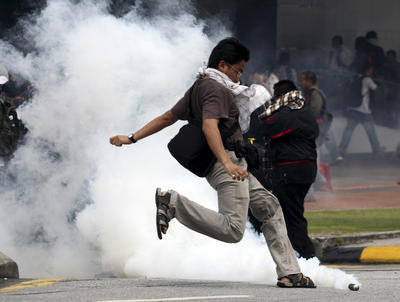The police had virtually locked down the city in anticipation of a public rally organised by the Coalition for Clean and Fair Elections, better known as Bersih in Malay (or ‘Clean’ in English), a coalition of 62 non-governmental organisations which was formed to advocate for electoral reform.
The first rally in 2007, now referred to as Bersih 1.0, which attracted an estimated 30,000 people, was seen as instrumental in catalysing the historic 2008 general election results, where the ruling coalition lost its much vaunted two-thirds majority in Parliament and the legislatures in five states. This time, the authorities pulled out all the stops in order to prevent a repeat performance, including declaring the rally, Bersih 2.0, to be illegal and putting the city on high alert in the week leading up to the rally.
Slightly after noon, groups of marchers began to emerge in various locations around the city, all of them heading towards Stadium Merdeka (‘Independence Stadium’), the symbolic location where the first prime minister of Malaysia declared the country’s independence from the British. Many of the marchers had stayed overnight in the city in case the police lockdown prevented them from re-entering. Among the marchers were many middle class non-Malays, who generally eschew participation in these public marches, including a sizeable number of college-aged students. But the marchers never made it to their destination. For approximately 3 hours the police attempted to disperse these groups using tear gas, water cannons, batons and shields only for the marchers to run and regroup in various locations around KL. Finally, at 4pm, the time when the organisers said the rally would end, the marchers, in two separate locations, sang the national anthem and dispersed peacefully.
It is not easy to resist the temptation of drawing parallels between the political events which have taken place in the Middle East and North Africa with the graphic images of police violence against the peaceful marchers in KL on this Saturday. But Malaysia is not Tunisia or Egypt. There was no occupation of a Tahrir Square equivalent nor was there a symbolic ‘Mohammed Bouzizi sacrifice’ (the Tunisian fruit seller who set himself aflame). Most of the 1,600 people arrested, including some opposition party and rally leaders, were released at day’s end. There is little chance that the incumbent governing coalition, the Barisan Nasional (BN), in power for 54 years since independence, will be overthrown by a popular revolution.
This is not to say there are no electoral costs to pay. Popular support for the BN will decline, especially in the urban areas, where voters have greater access to online sources of information including numerous YouTube clips showing video evidence of police brutality contrasted with the resilience of the marchers.
The political awareness of the marchers, many of them first timers, has also been heightened by this event. The participation of the middle class is particularly significant in further signaling the lifting of the veil of fear associated with street marches, with memories of the racial riots of 13 May 1969, which also occurred in KL, fading into irrelevance.
The demonstration of solidarity extended beyond Malaysia’s shores where, for the first time in history, Malaysians in over 20 cities around the world, including Singapore, Hong Kong, Taipei, Osaka, Melbourne and London, gathered together wearing Bersih t-shirts and displaying banners in support of Bersih 2.0.
But the electoral impact of the backlash against the ruling coalition is likely to be limited. Residents in the urban areas, where much of this backlash is located, are already voting in constituencies with opposition representatives. Most Malaysians who work or study overseas — and are much more likely to support the opposition — also cannot cast postal ballots.
Residents in rural areas, on the other hand, who are over-represented because of the uneven distribution of voters, do not have the same kind of access to online sources of information and, hence, would less likely be swayed to vote for the opposition because of Bersih 2.0. Residents in the states of Sabah and Sarawak, in East Malaysia, which account for 25 per cent of total parliamentary seats, are even less likely to be moved by the events in KL because of the strong state-centric focus among voters in these states.
It is unlikely that Bersih will organise another public rally before the next general election since its leaders have expressed their preference to submit the list of their eight demands to the King through other channels.
What this means is that the next general election, anticipated to be held before the middle of 2012, will be fought based on already established political issues, including the state of the economy, rising inflation, corruption and the always present policies associated with race and religion. Bersih 2.0 may have left a lasting impression among those who participated and those who followed the events closely online, but its electoral impact will be nowhere as significant as the images from the YouTube clips — an impact, not confined by space or locality, that may prove substantial yet.
Ong Kian Ming holds a PhD in political science from Duke University. He currently teaches public policy at UCSI University, a private university in Kuala Lumpur. He counts himself among one of the first time rally participants.
A version of this article first appeared in the China Daily Asia Weekly, 11 July 2011.

